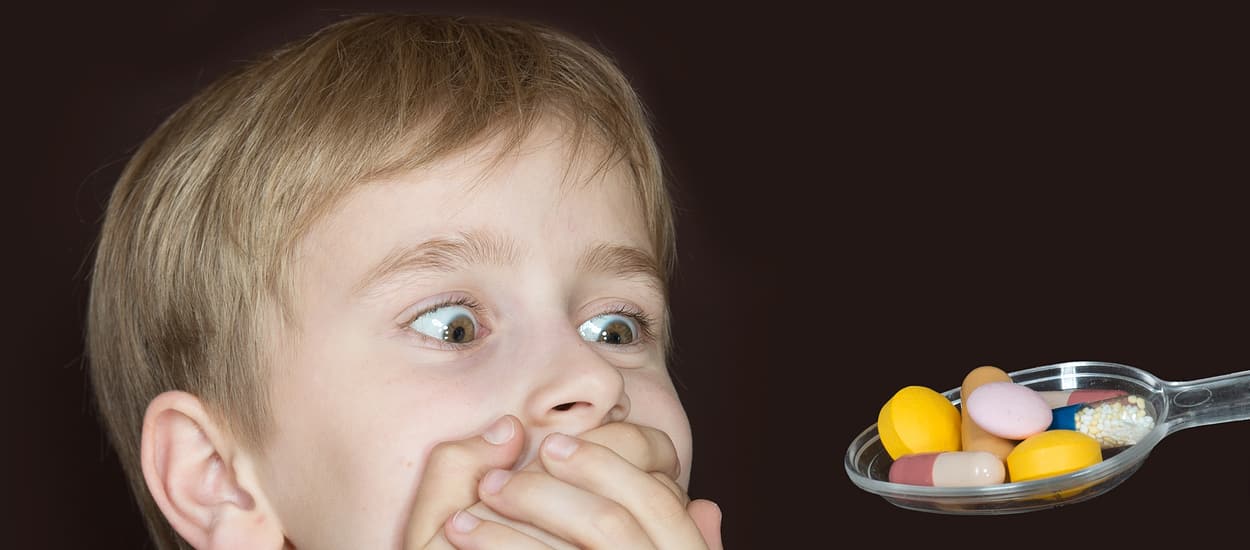Some children find it difficult to swallow pills. Just how many children have this problem is unknown. What we do know is that for most children who find it hard to swallow pills, the problem persists through the teenage years and even into adulthood. That’s if no one addresses the inability to swallow pills in a serious way.
Inability to Swallow Pills: Parenting Fail?
That’s a shame, because research has shown that children as young as 6-11 years, can be taught to swallow pills with the right methods and lots of patience. Researchers may know how to teach kids to swallow pills. Parents, on the other hand, may not know of any effective methods to teach pill-swallowing. They may even be embarrassed to discuss the problem with the child’s pediatrician, thinking it reflects poorly on their parenting skills.
Parents may struggle with their children for years over their inability to swallow pills. Some pills can be smashed and mixed into applesauce for easier swallowing, but many pills should not be crushed. Drug companies have offered chewable and liquid versions of the more common medications, but these tend to be pricier. Especially once children turn into teenagers and need higher doses for things like, say, ear infections. If you’re a parent with a teenager who can’t swallow pills, you know what it’s like watching the pharmacist line up all those bottles of amoxycillin on the counter. It’s both pricy and embarrassing.
That was how it was for Hallie Rich. Despite the fact that Rich was the third generation of her family to go into the  vitamin business, she never learned to swallow pills, and still cannot swallow them today. It’s why she came up with a product for adults, a multivitamin called AlternaVites, that can be placed on the tongue where it melts in the mouth (like a pixie stick) or mixed into food or drinks.
vitamin business, she never learned to swallow pills, and still cannot swallow them today. It’s why she came up with a product for adults, a multivitamin called AlternaVites, that can be placed on the tongue where it melts in the mouth (like a pixie stick) or mixed into food or drinks.
Well, that’s nice if you want to take vitamins, but medication is a whole different ballgame. Many, and even most medications, are not available in powder, liquid, or chewable form. At some point, children, especially those who suffer from chronic illness, must learn to cope, must learn to swallow that pill, like it or not. And many* do not. That’s the bad news.
The good news is that there really are ways to teach kids to swallow pills that really work. Here we outline two of the best methods: one that involves teaching children to swallow candies of different sizes, from very small to pill-size; and one that also has kids swallowing candies but with the head tilted in various positions, to identify the position that is easiest. The first method is quicker than the second, but both are successful.
NYU Child Studies Center Method
You will need:
- Seven sizes/shapes of candy for cake decoration
- Tic-tacs
- Water
- Cup
- Have your child place a cake candy (begin with the smallest-size candy) on the very back of the tongue, and swallow it down with a drink of water from a cup. Let the child do this several times until it feels comfortable. It should be simple for the child to swallow a very small candy ball, so this gives the child a positive start for building confidence. Praise the child.
- After the child is successful at swallowing five candy “pills” it is time to move on the next size, just slightly bigger than the first. Have the child swallow five such candy “pills” successfully, before moving on to each successive size. If the child succeeds in swallowing 3 pills, but fails on the fourth, for instance, keep practicing, until the child can swallow five “pills” in a row. Don’t extend the lessons for too long a period, or the child will begin to see the training as unpleasant. A typical training session will last no longer than 10 or 15 minutes.
- If the child moves on to a larger-size candy and is not successful, go back to the last pill size so that a training session ends on a positive note.
- At each session, start with the smallest-size candy. If the child manages to swallow it easily on the first try, move on to the next size, and so forth. If the child gets stuck at a size of candy she managed to successfully swallow five times in a row at the last session, stay with that size, and work to get five swallows in a row. Some children may make it through all the “pill” sizes on the first try. Others may need to work up to the largest size “pill” gradually over a period of 2-6 sessions. The tic-tac is the largest size.
- Time to try swallowing an actual pill (just once, please). It is rare that a child will make it through all the different sizes of candy in training sessions and then find it difficult to swallow the real medication. Your child will be so proud at mastering the art of pill-swallowing, and reaching this milestone!
University of Calgary Child Health Research Method
Professor Bonnie Kaplan has developed a protocol for training children to swallow pills. This method involves turning the head in different directions (tilted back, tilted forward, turned 45 degrees sideways). This method is based on the idea that changing the position of the head can open up the esophagus and prevent the gag reflex from kicking in as the child swallows.
This method takes more time than the NYU method. Parents need to work with their children for 10 minutes each night over a period of two weeks, until children are able to swallow using the head position they have found most comfortable. In research trials conducted at the University of Calgary, 33 out of 41 children succeeded with this method.
Prof. Kaplan and her research team created a series of training videos to teach this method. Here is one such film:
Happily for us, Kaplan and her team were so generous as to post the full set of training videos online for free. You can click HERE to see the full set of five videos. You will also find a link at the bottom of the webpage to 14 days of print-out reports to offer your child tangible proof of his or her success!
* According to Hallie Rich, some 40% of Americans have trouble swallowing pills.
